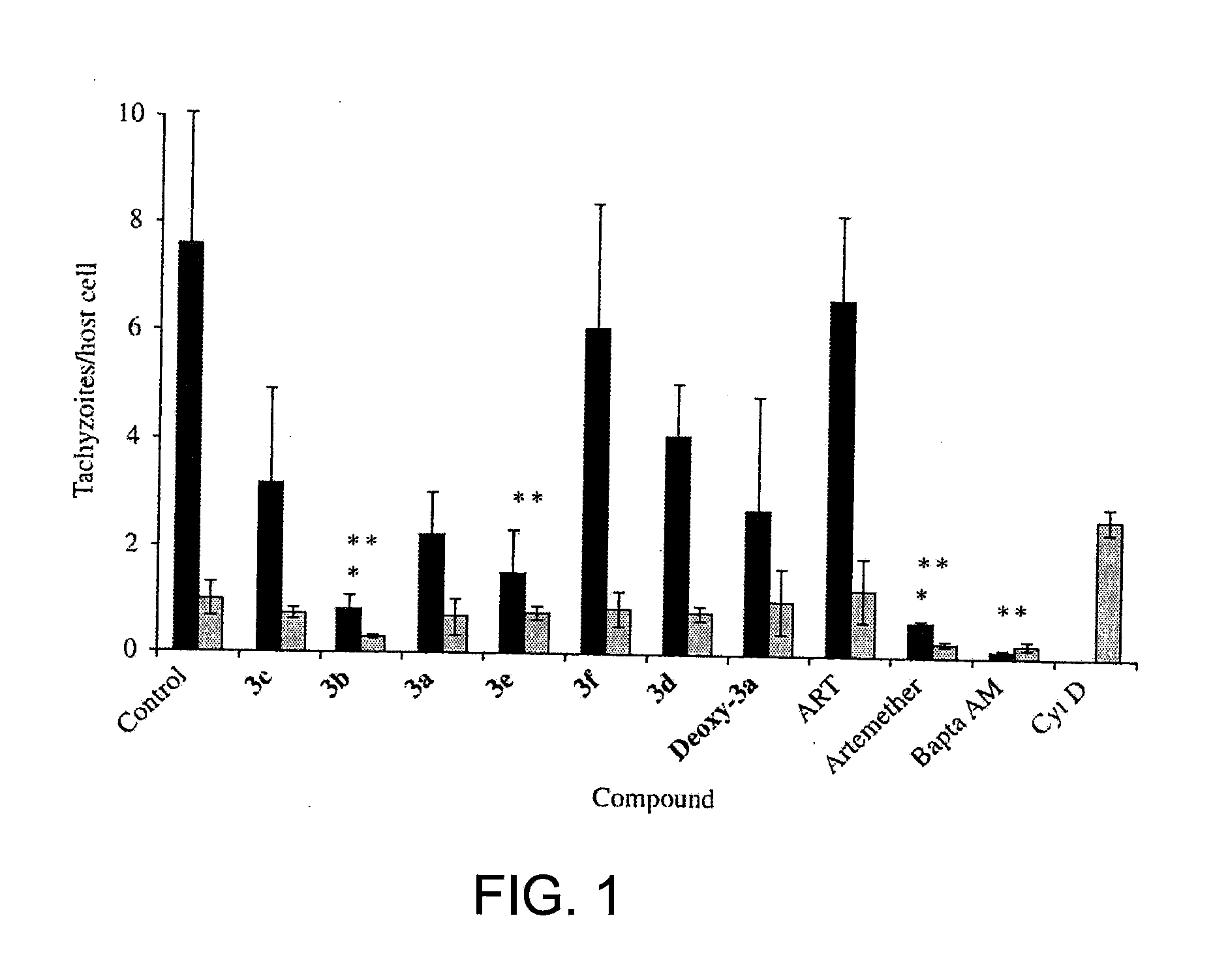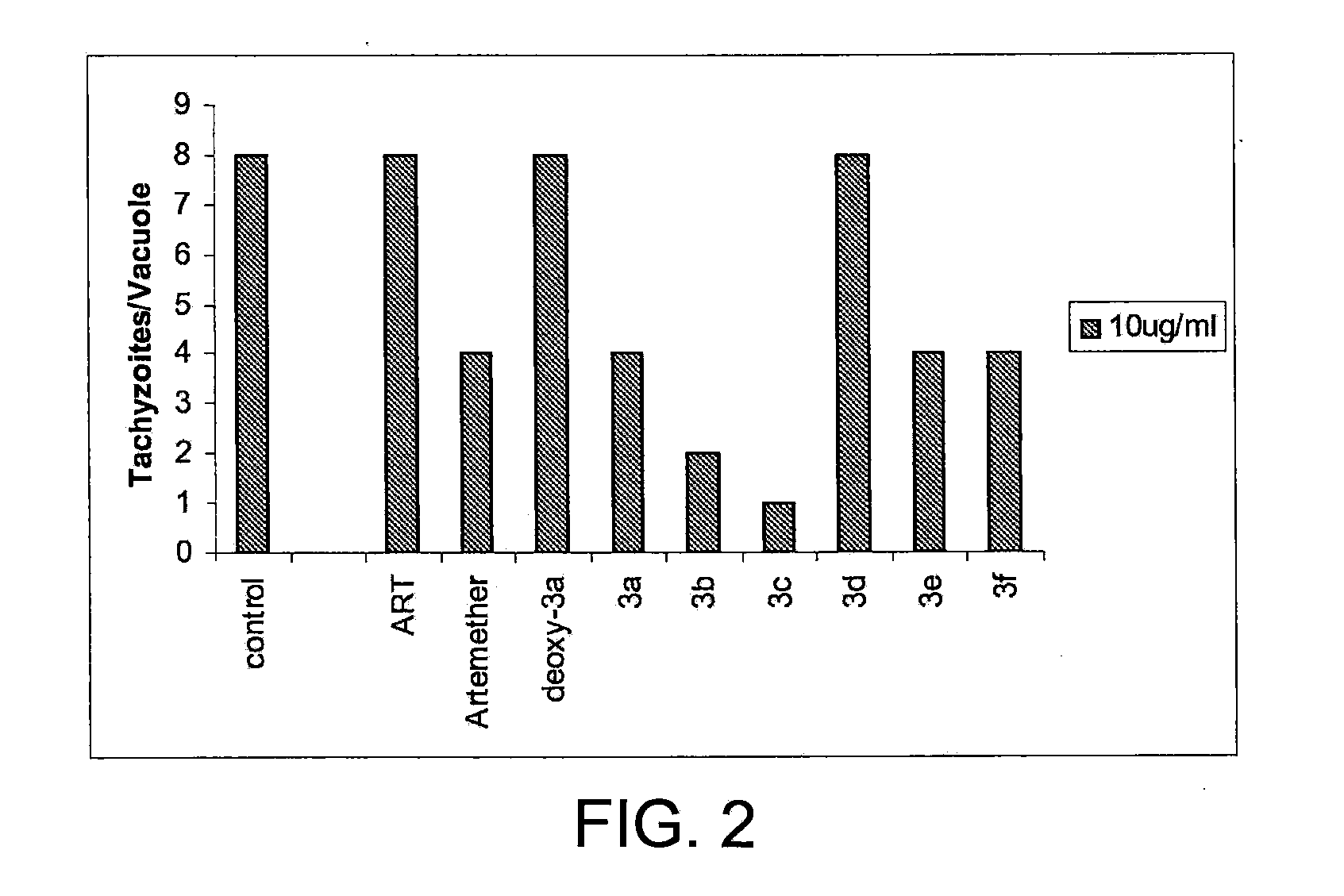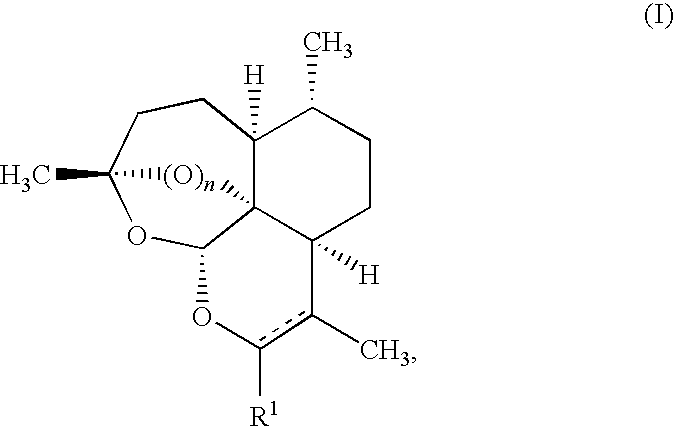Artemisinin Derivatives
a technology of artemisinin and derivatives, applied in the field of derivatives of artemisinin, can solve the problems of systemic infection, limited efficacy of available medications for the prevention and treatment of toxoplasma infection, and large side effects, so as to prevent, control or treat toxoplasma infection
- Summary
- Abstract
- Description
- Claims
- Application Information
AI Technical Summary
Problems solved by technology
Method used
Image
Examples
example 1
DART-Thiaz
[0179]
[0180]A flame-dried 100 mL round-bottomed flask, RBF, was loaded with a stir-bar, diethyl ether (Et2O), and 2-bromothioazole (0.88 mL, 9.92 mmol). The flask was immersed into a dry ice / acetone bath and after several minutes, n-BuLi (6.2 mL, 1.6 M sol in hexanes, 9.92 mmol) was added over 14 minutes. The mixture was stirred for 42 minutes at which time artemisinin (2 g, 7.08 mmol) in tetrahydrofuran (THF) (40 mL) was added over 18 minutes. After 45 minutes, acetic anhydride (4.8 mL, 50.3 mmol) was added and the dry ice / acetone bath was replaced with an ice water bath. The mixture rapidly became thick and a larger stir bar was added. After 2.5 hr, BF3 etherate (9 mL, 70 mmol) was added and the mixture became thinner and stirred freely. It was then stirred overnight, poured into a separatory funnel containing dichloromethane (DCM) (200 mL) and saturated aqueous sodium bicarbonate (100 mL). The organic layer was washed 2 additional times with saturated aqueous sodium bic...
example 2
DART-4-Me-thiaz
[0181]
[0182]A flame-dried 2 dram vial was loaded with a stir-bar, diethyl ether (880 μL), and 4-methylthiazole (17 μL, 0.18 mmol). The vial was immersed in a dry ice / acetone bath and after several minutes, n-BuLi (110 μL, 1.6 M sol in hexanes, 0.18 mmol) was added over a one minute period. The mixture was stirred for 45 minutes at which time the thiazole solution was added to a cooled (−78° C.) solution of artemisinin (50 mg, 0.18 mmol) in THF (880 μL) over 5 minutes. After 60 minutes, acetic anhydride (125 μL, 1.3 mmol) was added and the dry ice / acetone bath was replaced with an ice water bath. After two hours, BF3 etherate (160 μL, 1.3 mmol) was added and the cooling bath was removed. The reaction was allowed to warm to room temperature, RT, and stir at RT for two hours at which time the colorless mixture had turned light yellow. The reaction mixture was then poured into a separatory funnel containing dichloromethane (10 mL) and saturated aqueous sodium bicarbonate ...
example 3
DART-4,5-DiMe-thiaz
[0183]
[0184]A flame-dried 2 dram vial was loaded with a stir-bar, diethyl ether (880 μL), and 2-iodo-4,5-dimethylthiazole (42 mg, 0.18 mmol). The vial was immersed in a dry ice / acetone bath and after several minutes, n-BuLi (110 μL, 1.6 M sol in hexanes, 0.18 mmol) was added over a one minute period. The mixture was stirred for 45 minutes at which time the thiazole solution was added to a cooled (−78° C.) solution of artemisinin (50 mg, 0.18 mmol) in THF (880 μL) over 5 minutes. After 60 minutes, acetic anhydride (125 μL, 1.3 mmol) was added and the dry ice / acetone bath was replaced with an ice water bath. After two hours, BF3 etherate (160 μL, 1.3 mmol) was added and the cooling bath was removed. The reaction was allowed to warm to RT and stir at RT for two hours at which time the colorless mixture had turned light yellow. The reaction mixture was then poured into a reparatory funnel containing dichloromethane (10 mL) and saturated aqueous sodium bicarbonate (5 m...
PUM
| Property | Measurement | Unit |
|---|---|---|
| concentration | aaaaa | aaaaa |
| concentrations | aaaaa | aaaaa |
| concentrations | aaaaa | aaaaa |
Abstract
Description
Claims
Application Information
 Login to View More
Login to View More - R&D
- Intellectual Property
- Life Sciences
- Materials
- Tech Scout
- Unparalleled Data Quality
- Higher Quality Content
- 60% Fewer Hallucinations
Browse by: Latest US Patents, China's latest patents, Technical Efficacy Thesaurus, Application Domain, Technology Topic, Popular Technical Reports.
© 2025 PatSnap. All rights reserved.Legal|Privacy policy|Modern Slavery Act Transparency Statement|Sitemap|About US| Contact US: help@patsnap.com



